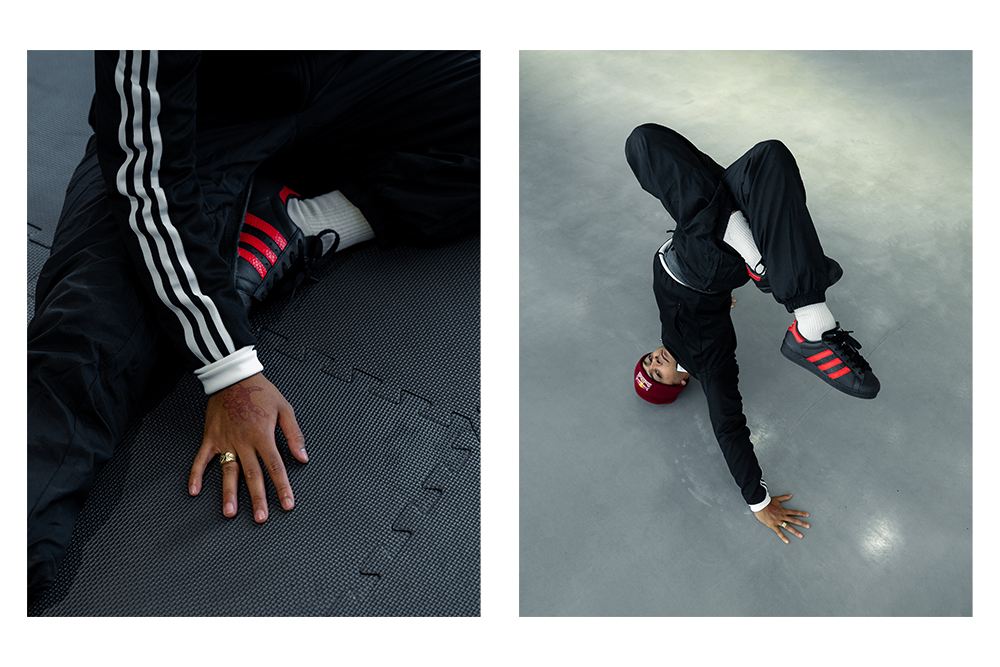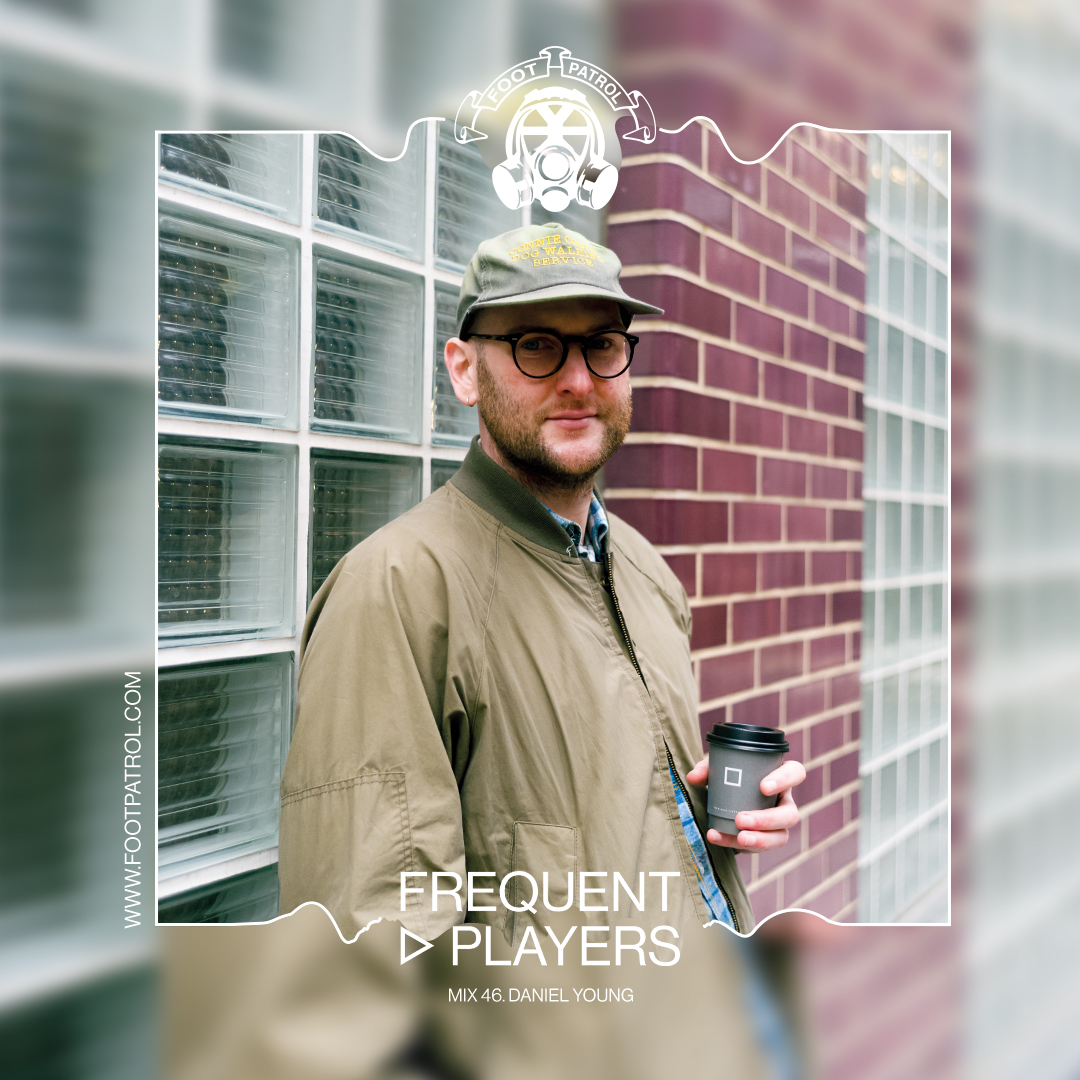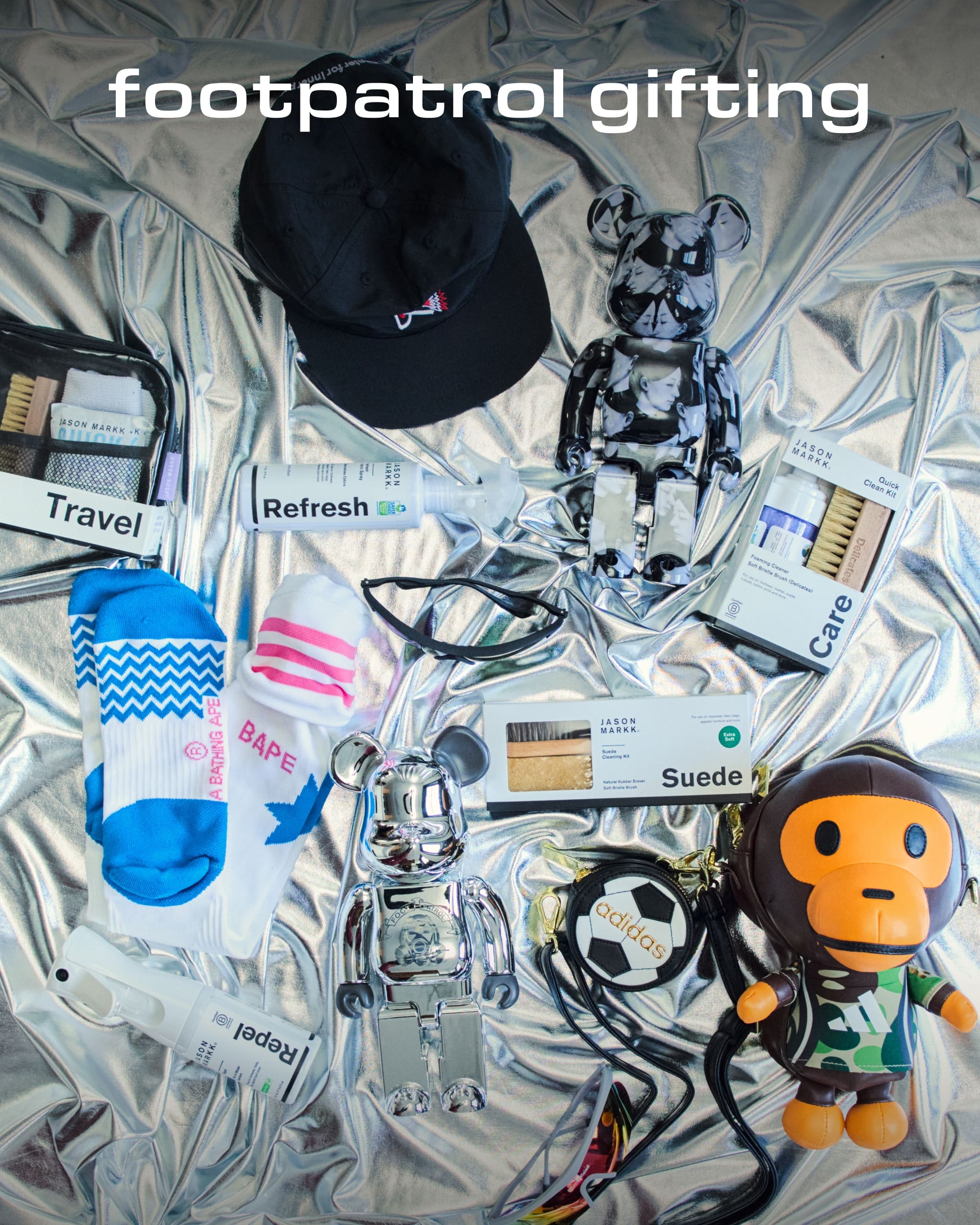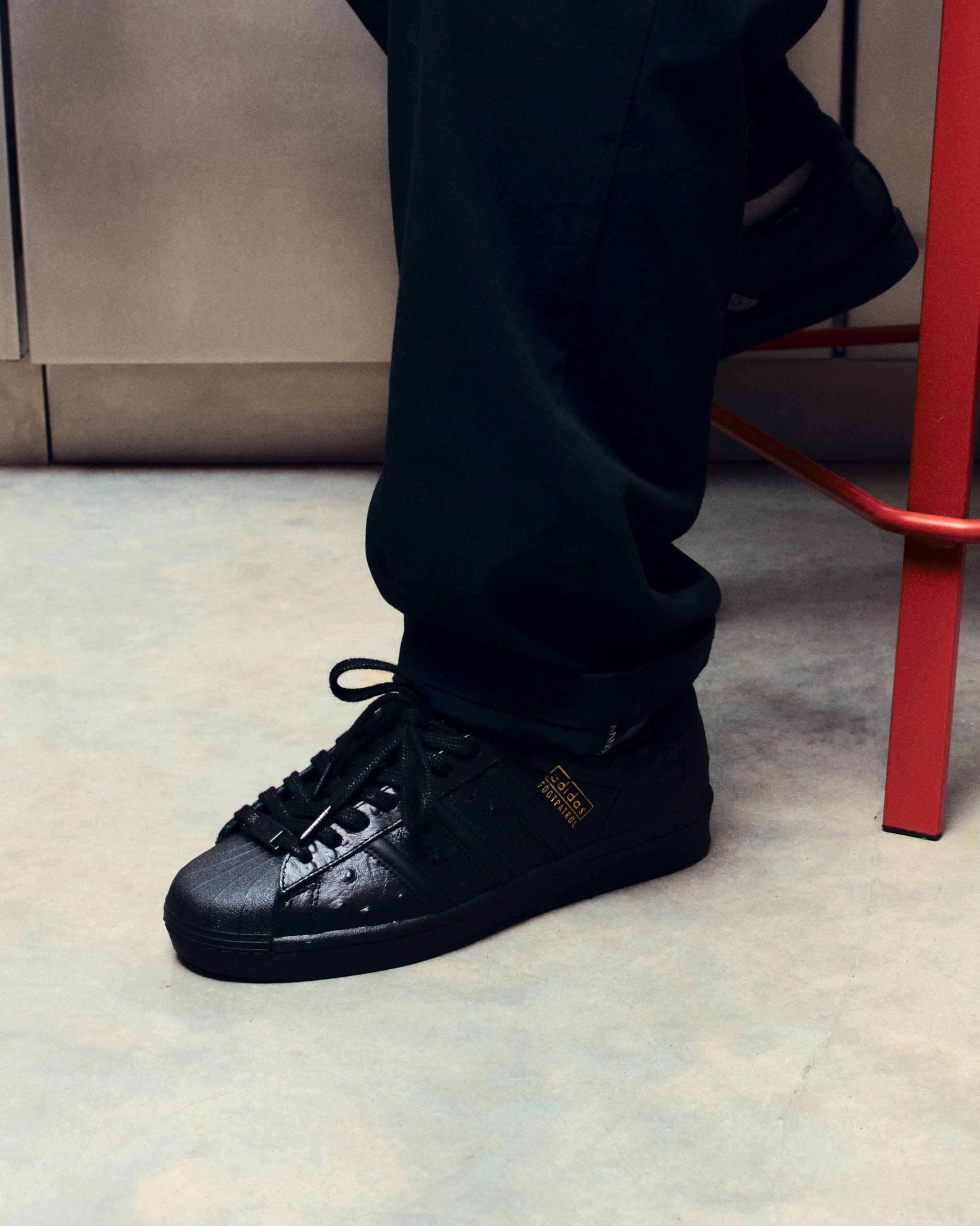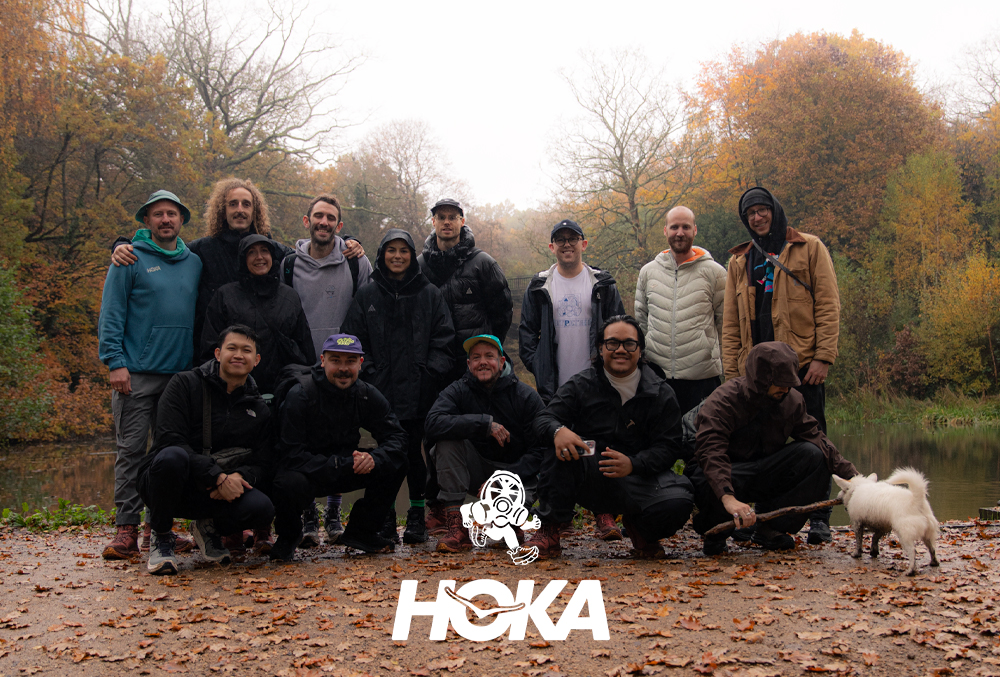Author: Bradley Martinez
One thing we always say about Frequent Players is how we aren’t bound by any genre and that’s one thing we aim to stay true too. Gearing up to the end of ’23, one of our final Frequent Players Guest Mixes of the year continues that trend.
Last week, Daniel Young popped by the shop to pay us a visiting whilst over from Ireland and we made the most of this opportunity to deliver Guest Mix 46 and show him around some of the record shops that are on our doorstep. Catching up over a coffee, we learn more about where this passion for music and collectable things come from and how Balearic music is the way forward for his live shows and this latest mix.
Footpatrol: Yes Dan, thanks for joining us at Footpatrol for our latest Frequent Players Guest Mix. Let’s kick things off with probably the most important question, how are you?
Dan Young: I’m great thanks – always nice to pop over to London. So good to catch up with you guys and thanks so much for asking me to be involved.

FP: I guess we should discuss music whilst we have you here… I always like to understand where your first memory of music comes from. I always find music is one of those things that can take you back to certain moments in your life, do you have a stand out memory growing up that kick started this love of music?
DY: If you ask my family, I’m sure they’ll tell you it was getting a copy of Seal – Kiss From a Rose (from Batman Forever – S/O Val Kilmer), but I’m not sure it’s been the driver for my interest!
I wouldn’t say I grew up in a massively musical household but my mum did play a lot of Spanish guitar music – think Gypsy Kings – we’ve always kept it Balearic in East Belfast.
I went through different phases as everyone does, I loved the Kevin and Perry soundtrack and at some point, I’m pretty sure 50 Cent changed my life. During what I would call my formative years, I was playing football with an older crowd and they were putting me onto things like Unkle, Fabric mixes and streetwear. This was my gateway to going out, meeting new people and from it all I just got a real bug for music and I continued to find my way from there.
FP: Whilst we had you over in London, we made sure to take you to a couple of stores close by to Footpatrol. It’s great to see people still rifle through vinyls and it’s definitely picked back up in fashion in recent years but what is it for you that makes listening to vinyl so important?
DY: I’ve always been a collector of things, I like tangible stuff – I think it’s a personality thing. I love being able to revisit collections of things I have years later. It’s an opportunity rediscover inspiration.
With vinyl though, there’s something amazing about getting into a shop and rifling through the racks. Either looking for something obscure or simply how I’d choose a bottle of wine, a great sleeve.
I wouldn’t call myself the most technical DJ either. I think for me what I enjoy about vinyl is more about the process of selecting and the sound of the tunes themselves. I do still play digital and I really enjoy it however, I just love the buzz of records, picking them out in the build-up to any sort of set and seeing how people respond on the day. For example, if your head is moving, I’m happy.

FP: Before delivering your mix, we relistened to your ‘Balearic Breezes to Melodic Explorations’ mix on your Mixcloud and noticed that genre was a common theme. What is it about this genre that’s got you hooked?
DY: Unfortunately I didn’t experience the whole Balearic beat phenomenon in Ibiza, but I just love everything about it. I love how some people have accidentally became Balearic icons. People like Chris Rea, Carly Simon and Marti Caine for example.
Also, if you try hard enough you can put anything under the Balearic umbrella. It’s that freedom and perspective that I love. I wouldn’t say this is the most Balearic selection I’ve put together but it feels on brand. For example, I always try to play some Dub and traditionally it’s not a staple in a Balearic set but I hope it’s what makes my selections a little bit different. I’ve been recommended so many songs by people that I probably didn’t think fitted into my rotation but have now become go-to’s.
I think Maccas (whose Frequent Players mix is also a cracker) mantra hits the nail on the head, “Balearic… but not too Balearic”.
FP: Aside from your mix, what’s five songs on your radar right now that our audience should check out?
DY: The mix was made up of a lot of new pickups, songs I forgot I owned and records I always pack when playing. Here’s five that I’ve recently picked up and have been featuring in the rotation.
Coyote – Lonely (Magic Wand)
Marcelle Moncrieffe – Take Me There (Athens of The North)
Deborah Glasgow – My Thing (Melodies International)
Moving Still – Sidi Mansour (Dark Disku)
Brian Auger – Night Train To Nowhere (THANK YOU)

FP: We see you DJing down at Sound Advice Records, seems like it has a great sense of community going on. How is the music scene out there in Ireland?
DY: Unbiased opinion incoming… The scene here in Ireland is incredible. There are lots of issues around licensing and spaces but what people do despite those challenges is really amazing.
I’m super lucky that Marion (owner of Sound Advice/Class DJ/Scene icon) has let me play records there a good few times. She’s been a massive supporter of me from the beginning and a big reason why I am where I’m at today. People like Marion are key to creating an inclusive environment to which everyone can feel a part of. Not just within Belfast but also further afield.
Playing records has introduced me to people I’ve always respected. To name drop a few, Marion, JC (DJ/Booker at Bullitt Hotel and maybe the nicest man in Ireland) and Mark Reid (Head Honcho of Touch Sensitive Records) here in Belfast and my favourite DJ/producer Moving Still (who has released on labels like CWPT and has an incredible boiler room set) from Dublin. All of which I’d call pals now, which is great.
There are so many amazing DJs, producers, and club nights in both Belfast and Dublin and I’m in a lucky position to be based between them both. If anyone is ever in Belfast/Dublin, fancies a pint and a recommendation about what’s on – give me a shout!

FP: Where would you like to take your DJing? Can you see yourself performing more? We think you need to get on to NTS for a cheeky guest slot…!
DY: haha, I think anyone listening would spend the show trying to work out what I’m saying instead of what I’m playing. Stations like NTS are a huge inspiration to me and are probably more aligned with my process of DJing. I still love the club as a punter, but to DJ in, give me a record shop, studio or nice wine bar any day!
I always find it weird to think of myself doing more than I am currently, or even what I’ve done to date. I probably played my first solo set about two years ago, and since then I’ve been given some amazing opportunities. From warming up for Macca, Moving Still and being asked to record something for you guys, all of which are miles away from what I set out to do.
These last few years have been filled with some incredible moments. I’m really excited about what is to come next. I’m getting married in April and for our honeymoon, we’re heading to Japan so I’m hoping to try and play somewhere during the trip. That would be a real bucket list moment.
FP: Having followed each other for what feels like decades now, I’ve always known you as someone who appreciates good design and music so it’s great to see you kickstart your ‘Iris Magazine Store’. Could you tell us a bit more about this venture?
DY: I think Iris is the thing that has been the most natural in my life, probably because I get to run it with my fiance Aoife. Going back to my point about collecting things, Aoife is the same. We’ve both collected magazines for years (of all genres too) from Popeye, Gentlewomen, Disco Pogo and more. Iris was born out of a lack of access to what we love in Ireland, we wanted these magazines to be accessible to everyone and maybe introduce some of those titles to a new audience. It’s not really work for us, it’s something we’re both so passionate about. It also feeds our magazine habit.
FP: Well, thanks once again for taking the time to sit down with us and deliver your mix. We tend to leave this last question as an open one, a chance to let our audience know of anything you’ve got coming up or any words of wisdom that have helped your along the way so the floor is yours…!
DY: Nice one, thanks again for having me. I always wanted to start DJing before I did, and just didn’t feel confident enough so I think an important message for anything you feel unsure of, is to just go for it. You’ll find people are more supportive than you think. Other than that, keep an eye out on @irismagazinestore on Instagram for your magazine fix and @danielyoungfleh to see where you can catch me for some tunes and a pint of Guinness this Christmas.

Already a year on from when we launched Inclusive Access ’22, we’re back for round two. Continuing in similar fashion, we’re on the mission to encourage and normalise conversations surrounding disabilities. It became wholesome occasion that brought to light many topics that were either misunderstood, unspoken or both. As we promised last year, this conversation will not stop there.

Staying true to our word, we introduce ia23. Our aim? To continue pushing the industry and community to become an even more inclusive space, a space for everyone. For this, we’ve once again teamed up with both OPEN BOOK and Two Times Elliott.
This years topic of choice is one very close to the Footpatrol team, sport. A frequent topic that came up last year, and with the Paralympic Games 2024 being hosted in Paris, we felt this was the perfect opportunity to widen this conversation. With an amazing series of panelists on hand to promote the conversation, we’d love for you to join us and join in. If you’d like to join us for another night to remember, please send your RSVP to RSVP@footpatrol.com. We’ll get back to you as soon as possible confirming your attendance. Please note we will be limited in capacity and apologise in advance.

At the Footpatrol Run Club, you could say we’re use to our heart rates being tested. Whether it’s racing in the Oxford Half Marathon or taking part in the Amsterdam Marathon, things tend to be a lot more faster paced. Last week however, things were a little different. Teaming up with HOKA, we put on our first ever wellness walk.
We’re constantly being told how our mental health is important however, we feel it’s a subject people are still afraid to talk about. We wanted to break that mould. That’s where we wanted to encourage the idea of conversation. With HOKA team member Jhon on hand, we were also joined by two wellbeing advocates in Jimmy Watkins and Samo White. Each one took a moment to show courage, open up and share their story and promote a topic of discussion. From identity to community, from addiction to gender. We discussed in our own ways how each topic has effected us whether it be big or small and how we can promote change.
A huge thank you to everyone who came down and participated. It was a wholesome morning spent on Hampstead Heath with the rain dampening no spirits. With that said, a special shoutout to the Tor Ultra GORE-TEX. That upper and chunky midsole meant for zero slip ups!









For all of their collaborators, few have stood the test of time more than Y-3. Since it inception in the early 2000’s, adidas and Japanese designer Yohji Yamamoto have been a fusing of minds. The mission? To create bespoke collections that aim to push the boundaries of the adidas archive.
Collaborations between high end fashion brands and sportswear giants aren’t anything new. In fact, over recent years they’ve become a thing of norm. However, Y-3 have been building this connection since their debut collection back in 2003 and have gone on to build a cult like following.
Y-3 always focus on innovation and materials which often led the way when it comes to new concepts like the Y-3 Qasa from 2013. A standout silhouette still to this day. The idea was to bring a contemporary approach to adidas’ archival Tubular technology. With that underfoot, the upper became a masterpiece of avant-garde inspiration. Premium comfort and a futuristic design paved the way for future examples of the model. Continuing the trend, they swiftly followed this up with the Y-3 PureBOOST (2014), Y-3 Run BOOST (2016) and the 4D Runner in (2018).
Now for their FW23 collection, the those avant-garde theme continues. This time, we even more recognisable silhouettes, concrete greys are met with bursts of yellows whilst exposed stitches and loose threads replace the iconic sidewall Three Stripes. Take a closer look below and check out the latest offering online at Footpatrol here!







Music has always been a focus here at Footpatrol. In line with Frequent Players, we partnered up with New Balance in hosting an in-store listening party celebrating the launch of Lord Apex’s new album, ‘The Good Fight’.
It’s not every day you get to speak to the sensei, so we took our chance to catch up with him and find out more about his journey so far.
FP: Lord Apex, great to have you here with us. How are you?
LA : I’m great! Thank you for asking, man. It’s still one of the world’s most underrated questions. So I appreciate every time I hear it, bro. How are you doing?
FP: I’m good thank you, interviewers rarely get asked that!
LA : Yeah, bro. I can’t help but ask. I’m speaking to somebody, you know what I mean? So, I’m not, not gonna ask you. You don’t wake up and slap an interview on your head, you know what I mean? You’re a person.

FP: You’ve been a busy guy traveling, dropping new music and doing shows. Life seems like a movie for you right now, how you been finding it?
LA: Man, it’s been a movie for me since I was like seven years old. It started off like ‘Cheaper by the Dozen’ or a PG 13. Now we have an R rated movie, bro. I mean, we be taking life by the balls. It’s cool! More than anything, my whole energy is just waking up grateful.
I pray every morning, every night. I’m very thankful to be in the position I’m in, whether I felt like it’s like God given or a blessing. My main thing is just being thankful.
FP: That’s a good way to look at it. I feel like a lot of people these days carry some sort of ego with these things.
LA: Don’t get me wrong, I felt like there was part of me that had a big ego and I just had to kill him off, but now I can look at him from an outer body perspective and bring myself back down.

FP: From bamboo forest, all the way through to some of your recent projects with Cookin Soul and now Madlib. Your discography keeps on elevating. Did you ever see things going this way when you started?
LA: Pun intended every time. I’m always going to elevate, because that was the plan. There’s no way I can’t remind myself that we want to be doing better than we did last time. So even down to collab, I would never put people on levels in terms of how big they are. Whenever we get together, that’s a whole different experience. Even with Madlib, everything else he’s done aside, I think it still would have come out the same way. But outside of that, it was just a beautiful experience to be able to get that done.
It did a lot for the kid in me. And it made me feel like I should keep inspiring people to go above and beyond for real.

FP: How do you go about choosing who you work with, it’s such a diverse mix of artists and producers?
LA: I’m very big on just being in the present. Very Gemini in terms of the music I want to create. It changes all the time. It could be like one day, let’s just get trappy. So, For me it really varies on what vibe I’m in at the time, what music I’m listening to.
It naturally becomes something different.
FP: Do you have a list of people you’d one day like to work with or you just freestyling or now?
LA: Ah, you know what? I would like to one day be seen as that actor that everybody wants to work with, you know? Every director needs him as opposed to me having a crazy list. I’ve got a list and the more I see that list, the more it changes and fluctuates.
So right now I could sit here and be like, Alchemist, Primo, all that shit.
I also wanna know who produced Toxic for Britney Spears, you feel me? Let’s go crazy. Let’s get crazy. Get me in there with them Swedish boys, man. Like, Screw That Click, all that shit. I grew up heavily inspired by DJ Screw, so I would love to be on, some of that, Houston type slow down. You know what I mean? I love that Memphis sound all sped up. But I like the Florida sound too and thats sped up twice as much. So it varies, but I listened to so much. It’s only weird if you don’t know that I’m into that music as heavy as I am.

FP: I know you’re a man that’s trying to push your own boundaries with your music. Do you have a direction as to where you want to take things later in life?
LA: Life’s the direction.
FP: How do you look to elevate your sound?
LA: Production. I feel like that’s the next step in terms of solidifying my sound. I want to hear a song and be like, yeah, this is a flat song. But before the lyrics come in, you know what I mean? I’ve always had a good ear for beats. Even before I started making music.
FP: One thing we’ve always loved is the visuals in your music videos. Do you do the creative direction yourself for each project?
LA: I like to do a mixture of both where we have a set. We kind of have a set family that we work with all the time. So like my guy Above Ground. He’s probably shot my best videos. All the ones that we’ve done on film, like Speak for Yourself, Life Goes On.
I’m glad we get to document the journey because, instead of me having to tell people like, yo, this was like this or that like the listening event tonight for example, it’ll be documented, but then it’s documented on a Bolex. It’s beautiful.
I love films, I study films. So I always try to put effort in my visuals.

FP: You are also prepping for your 2024 EU & UK tour for your latest project The Good Fight. What can you tell us about this latest release?
LA: What can I tell you? Man. UK wise, definitely critically acclaimed. I feel like wherever it stands, it might not get in the conversation immediately. But then that might be something that also comes as a surprise to me because I’m my worst critic.
When it comes to me critiquing myself in terms of how I’m viewed in the UK, in my eyes, it’s always a bit more negative. In the beginning, when I was still in ego mode, I felt like there were a lot of conversations I was getting left out of. But in retrospect, bro, who cares? I enjoy making music and my favorite thing to do is represent everybody that feels like they resonate with the space I’m in.
FP: Sensei, it’s been a pleasure. Thank you again for having the chat with us, before we let you go. Can we get 1 fun fact about you that people may not know about?
LA: Fun fact about me is none of the things I’ve done in the last three years would be possible without Max and Connor over there. [points at his team]

One thing we love to explore at Footpatrol is technology and performance and how those two worlds combine. As well as our usual offering of exclusive and rare sneakers, we also offer a whole range of performance silhouettes from a number of our usual brands. From daily runners from the likes of HOKA, through to the latest trail conquering runners from norda, ON or Merrell or the latest in carbon technology from Nike with the NEXT% division we have something for everyone in their pursuit of performance.
One thing we were missing within our arsenal however is performance apparel. Now though, we welcome District Vision to our range of brands.
After a series of life changing events, District Vision was founded in 2016 by Tom Daly and Max Vallot when the pair discovered the joys and benefits of running and meditation and here lies the brands key message. Constantly researching and developing tools to help others become mindful athletes, the brand look to create products with a function-first and performance enhancing mentality which at the core is a foundation of well-being within the form of physical exercise.
Now seven years in and to welcome the brand at Footpatrol, we took some of the latest collection down to the wet and windy English South Coast with local runners Fey and Arran. Check out more below and why not check out their latest collection available to shop online at Footpatrol here.



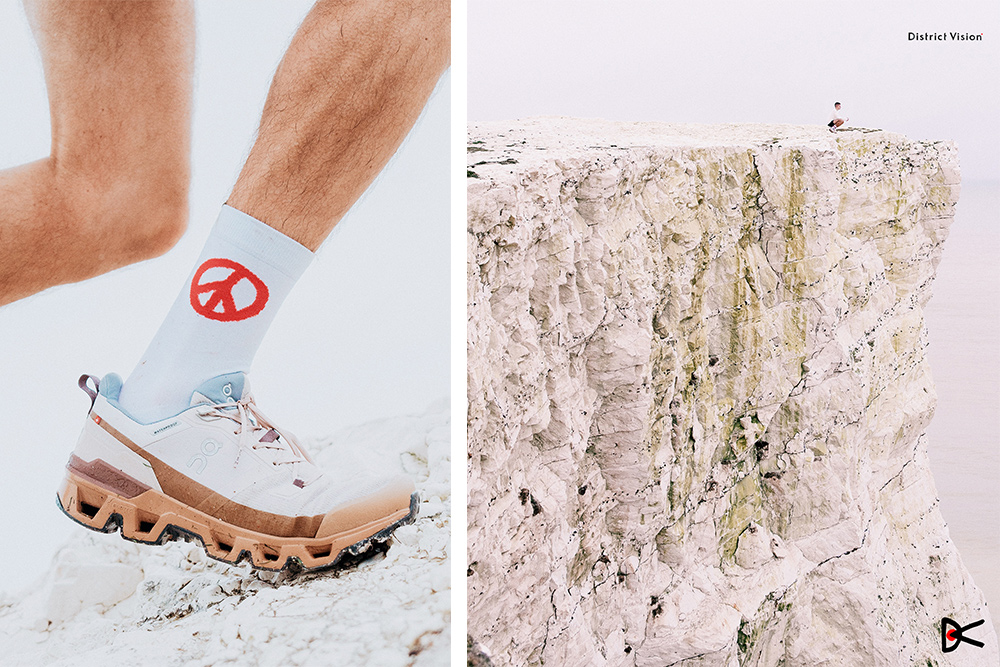








Sometimes within the world of contemporary fashion and footwear it’s hard to stay true to yourselves. Where trends are constantly changing within the blink of an eye, Hender Scheme manage to buck that trend. Defying the fast-paced nature, they’re standing strong against the mass-produced norms.
Founded by Ryo Kashiwazaki in 2010, Hender Scheme entered the fashion world with its unique approach to craftsmanship, redefining the way we perceive and appreciate footwear.
At the core of Hender Scheme’s philosophy lies a deep reverence for craftsmanship. Each pair of shoes produced by the brand is a testament to this devotion, as they are meticulously handcrafted in small workshops in Japan. Ryo Kashiwazaki, the brand’s founder, believes that the art of craftsmanship is not just about creating products but also about infusing them with a sense of personality and character.

Hender Scheme’s footwear is made using traditional shoe-making techniques, emphasising the use of high-quality materials and artisanal skills. This commitment to craftsmanship is a refreshing departure from the disposable, mass-produced ethos that can tend to dominate the industry.
One of the standout features of Hender Scheme is its embrace of raw, natural aesthetics. The brand’s shoes are intentionally designed to age and patinate over time, giving them a unique and personalised appearance.

The untreated leather used for the uppers of their footwear is meant to develop a distinct patina, much like a fine wine. This concept of aging gracefully not only adds character to the footwear but also encourages consumers to form a deeper connection with their shoes. Hender Scheme believes that beauty lies in imperfections and that each scuff or blemish tells a story, making each pair of shoes truly one-of-a-kind.
Hender Scheme is well-known for its reinterpretation of iconic footwear silhouettes. The brand takes classic designs, such as the Nike Air Force 1 or the Adidas Superstar, and recreates them with a unique twist. These “homage” designs are executed with impeccable attention to detail, and they offer a bridge between the worlds of high fashion and streetwear.
Hender Scheme has cultivated a devoted cult following of fashion enthusiasts who appreciate the brand’s dedication to craftsmanship and unique aesthetic. The brand’s limited production quantities contribute to the exclusivity and desirability of its products. This scarcity often leads to customers waiting in anticipation for each release, and it underlines the brand’s commitment to quality over quantity.
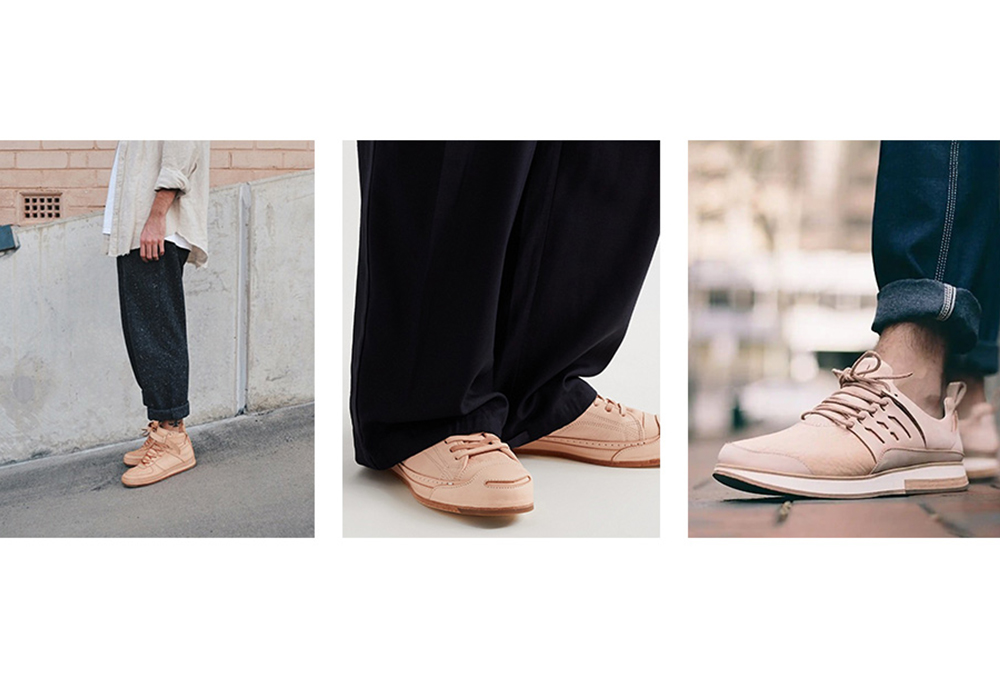
Nike makes history this month as it prepares to release the first-ever physical sneaker under its .SWOOSH Web3-enabled platform. Created as part of Nike’s “Your Force 1” campaign, the design competition challenged sneakerheads to jump into the next digital frontier of footwear. .SWOOSH Studio allows users the ability to be the creative director through a collaborative design process with a Nike designer that prioritises creative storytelling over creative skills.

This isn’t the first time Nike has dipped its toes into the Metaverse. In December 2021, the footwear giant announced the acquisition of RTFKT, a leading brand that leverages cutting-edge innovation to deliver next-generation collectables that merge culture and gaming. The move is another step that accelerates Nike’s digital transformation and serves the growing cohort of Gen Z consumers who perceive no difference between physical and virtual reality and experience the metaverse with fluidity.
Daniel Bailey, co-founder of CONCEPTKICKS and footwear designer better known as Mr Bailey recently spoke to Highsnobiety on the endless creative and commercial possibilities offered by the metaverse. “I think over the next couple of years it will become the norm to buy sneaker NFTs, balanced with physical versions of that same file/design. It’s without a doubt the present and future of the industry,” he explains.

Grounded on the blockchain, NFTs have been making a big splash in the fashion world with major luxury and streetwear brands investing in the digital universe. You only have to look at the astronomical sums generated in Nike’s recent NFT auctions to see why they are banking on the metaverse. The CryptoKicks collection, auctioned on online marketplace OpenSea saw customers pay between $4,000 and $9,500 in cryptocurrency for the shoes, with some pairs selling for well over six figures. By comparison, a pair of Nike Supreme Stars Mean Green SB Dunk Lows were selling Thursday on StockX for roughly $1,000. In October, a pair of Nikes that Michael Jordan wore during his rookie season in 1984 sold at auction for $1.47 million.
The inclusion of the sneaker community is a big part of the success of the digital footwear revolution. .SWOOSH platform gives your average person who may not be super familiar with the space an opportunity to explore digital designs, while the voting element of the contest invites the sneaker community as a whole to decide the best sneaker to get the IRL treatment. SoleSavy uses a similar community-focused approach by dropping its limited-edition custom SS4 sneaker and NFT physically and digitally. This virtual and physical mix allows designing innovative ideas and creating a parallel world where one’s avatar can go shopping, make friends, and have a “second life”.
NFTs aren’t the only digital design tool disrupting the footwear industry. Over the past year, AI sneaker designs have swept social media with digital artists creating their own dream versions of familiar kicks. IG account AI_ClothingDaily, which is run by luckynumber.8, is one particular page that has gone viral for its AI-generated Nikes. Each pair takes a familiar Nike silhouette — such as the Air Force 1 and the Vapormax — and gives it a lace-centric, intricate makeover.

The computer-generated designs prove the incredible potential and abilities that AI holds. It hasn’t come without criticism though. Many sneakerheads on social media are sceptical about this derivative design approach, one which sees keywords tossed into an aesthetic blender rather than creating their own new ideas. There is also the question of whether AI-generated creations unfairly exploit others’ intellectual property. But for all the concerns, these fan projects are undoubtedly pushing the industry to explore how designers can and will collaborate with increasingly sophisticated tools—including manipulable datasets that encompass lifetimes of design influences and precedents.
Adidas has already openly signalled that it is building AI into its design flow. Last April, the German sportswear brand celebrated the arrival of the latest Ozworld collection, by launching the world’s first personality-based AI-generated avatar creation platform, in collaboration with Ready Player Me. Designed to empower and open up the pursuit of self-expression for consumers, the online Ozworld experience enables users to create their unique digital selves, which can then be taken around the web exclusively with Ready Player Me – a cross-app avatar platform for the metaverse that allows anyone to explore virtual worlds with one consistent identity. “Whether IRL or URL, the Ozworld collection boldly represents a platform for style experimentation and a rallying call for the pursuit of personal expression,” adidas said of the line.
These virtual sneakers arrive at a time when the footwear industry has been thrust towards digitalisation with new technologies accelerating advancements and changing the face of sneaker design as we know it. Innovation has always been at the forefront of the industry but with 3D printing and robotics streamlining processes and becoming more commonplace, digitalization in all its forms will be the main factor shaping the industry moving forward.
Luxury brands like Dior and Givenchy have been some of the first to implement digitalization into their seasonal footwear. For A/W 23, Dior Men debuted a pair of 3D-printed derby shoes as a modern translation of the Maison’s Carlo model. The team 3D scanned the original leather Carlo Derby and applied a digital texture to its surface. Once transformed in digital space, the new rendition goes through a 12-hour printing process before emerging from a powder bed where it is given its final finishing touches.

As Thibo Dennis, head of footwear at Dior Meen notes, “It’s a highly meticulous process, similar to a couture embroidery of craft technique, to arrive at this level of perfection and this level of finishing.” He says that while the style may look visually aggressive it is actually very soft and ultra-lightweight when worn.
Givenchy’s Creative Director Matthew M. Williams is another designer who has been breaking new ground with digitised footwear. Givenchy’s innovative TK-360 sneaker encapsulates the designer’s contemporary approach to Givenchy’s historic association with savoir-faire and craft. The shoe’s sleek and sporty shape is achieved from a singular piece of stretch-knit fabric, crafted directly onto the custom-moulded sole giving the sneaker a unique tread and entirely monochrome appearance. Williams calls it his ‘dream shoe’. “There is a sense of savoir-faire for sportswear created at a fashion company like Givenchy that is different from a sportswear company, but no less rigorous,’ Williams told Wallpaper.

Aside from cutting costs and lead time to the production process, these digital technologies offer environmental benefits too. Both the Carlo Derby and TK-360 are created entirely from mono-materials, which means any post-industrial waste can be recycled back into the system.
“80% of the material is entirely reused for other purposes,” says Dennis. “It’s a circular approach. It’s continuous. It’s virtuous.”
These innovations certainly don’t come cheap. Dior’s Derby will set you back £1850, while Givenchy’s TK-360 comes in at £695. But these luxury price points aren’t entirely reflective of how digital technology is being scaled into the mainstream. 3D printing and 360 woven techniques are actually lowering the barrier to entry as it eliminates the required investment of money and time. This is something that both big and small brands have highlighted and benefited from. adidas has scaled to the mass market with its 4D and Strung projects, while start-ups like Zellerfeld are making waves with their use of circular 3D printing
Heron Preston, who collaborated with Zellerfeld for the HERON01 sneaker, says he is trying to put a printed shoe on every foot in the world. “When I first met Cornelius from the 3D tech company Zellerfeld, he spoke to me about things like the economics of the photography industry, recycling plastic, the anatomy of the human foot, the history of footwear development and a vision of a sustainable future where we would no longer need multiple pairs of shoes,” says Preston on his venture into digital footwear design. “He explained to me, what his breakthroughs meant for footwear designers around the globe with big dreams and unrealized ideas. It was at that moment when I realized our ambitions for a better future were a match.”
According to Preston, Zellerfeld’s technology will usher the footwear industry into a future where creatives can independently realize their footwear concepts in a tangible, and commercially viable form. “You can produce as many pairs as people order, each one being personalized to the individual’s unique foot shape with a foot scan – and once the product starts to wear out, re-use that same material to print more, that material being 100% recycled plastic bottles.”

Unlike traditional footwear drops, Zellerfield and Preston released the sneakers as beta editions where the community would wear-test the shoes and provide feedback for the next edition. “From the first round of beta testing we were able to use the feedback to improve the design,” says Preston, going on to reveal how the second fully 3D-printed silhouette evolved with an improved collar shape for easier entry, softer upper, reduced materials as well as other improvements to the shoe’s overall fit and form.

What is most interesting about this new generation of digital designs is the new aesthetic direction that it is pushing footwear into. No longer restricted by confines of detailing like lace systems, panelling and tooling that goes into traditional sneakers, this new wave of digitalised design takes footwear in an entirely futuristic direction. Organic forms, ultra-high-tech materials and lightweight three-dimensional patterning give a peek into what footwear will look like in the not-too-distant future.
Emerging label Scry, founded by Zixiong Wei, is a great example of how footwear brands are blurring the lines between the digital and physical. Working on the intersection of art, design, technology, culture and environment, the brand is using cutting-edge innovation to bring avant-garde designs into real life. Its daring 3D-printed shapes and prototype-esque sneaker platforms can be produced in as little as two weeks and are often produced on demand, allowing the label to offer a sustainable alternative to mass-produced sneakers.
“I think SCRY is always exploring different future possibilities, rather than pursuing lighter, faster, and more resilient ones,” the 22-year-old founder told Hypebeast. “Sometimes, it is not the internal industry that disrupts an industry.”

Wei is already busy building an online design platform on SCRY to open design rights to the public. He sees these platforms as an essential tool for creating a more “free and diversified” footwear industry in the future. “Technology will promote the progress and collision of footwear design.”
When asked whether digitalised designs will take over from classic leather sneakers, Dennis states that “more than ever, I think the classic cup sole and nice leather would always exist.” He believes that besides the technology of digitalisation, sneakerheads will always be happy to wear a classic silhouette. “I think the future of sneakers is not only in 3D print but also in craftsmanship. To make everything more qualitative.”
Preston believes that it is the move to responsible design and on-demand production that will help usher in 3D printing into the future. “Removing all of these materials: removing the stitching, removing the glue and having just one mono-material. That innovative process is what is going to carry us into the future,” ” he says. “For a young sneakerhead or a young designer you can sleep on a design and hit print then you have that footwear in your hands that is wearable. That’s unheard of.”
Words by Samuatro
In a follow up to our previous 9fifty cap with New Era Europe, we once again team up with the headwear specialists to produce another story telling piece. Taking inspiration from both our bricks and mortar stores, London and Paris, each 59fifty cap will sit exclusively to both stores. With that said, each of these latest additions will pull influences from the city streets that surround the stores.
London pulls on a classic phrase, the ‘Big Smoke’ for a deep black peak with matching black details whilst the Paris edition opts for what France is famed for… wine. A burgundy peak is a subtle hint to this with details throughout in a matching palette.
Each feature matching graphics with the Footpatrol Monogram logo on the front, a Footpatrol bar logo along the side whilst at the back, a sense of exclusivity is clear with a nod to each city in a chain stitch-style embroidery.
To celebrate this launch and the city of London, TEAMFP member Fola caught up with friend of the store Moses to take him around some of his favourite spots. Take a look below at where we ended up and make sure to check out the latest Footpatrol x New Era collection in-store & online here!










Earlier this month, we teamed up with adidas Originals to redefine what Originals meant. For this, we teamed up with Benji aka, Blunt Shank. After sharing his love of the Superstar silhouette across forums back in the day, this b Egan Benji on his path to where he is today. Now creating bespoke and customs, ourselves and adidas challenged Benji to create a one-of-one Superstar to B-Boy Olympian talent Sunni Brummitt.
A performer at the highest level, Sunni has travelled the globe sharing his talents. Having started at the age of 10, Sunni has set his sights on the main stage at next years Olympics.
Excitingly, we recently had the opportunity to hand this pair over to Sunni. After lacing up the Superstars, displaying his talents, Sunni set about sharing with us his what Originals meant to him.

